Ranger Electronic DX-929 CB Transceiver User Manual users manual
Ranger Electronic (Shanghai) Inc CB Transceiver users manual
users manual
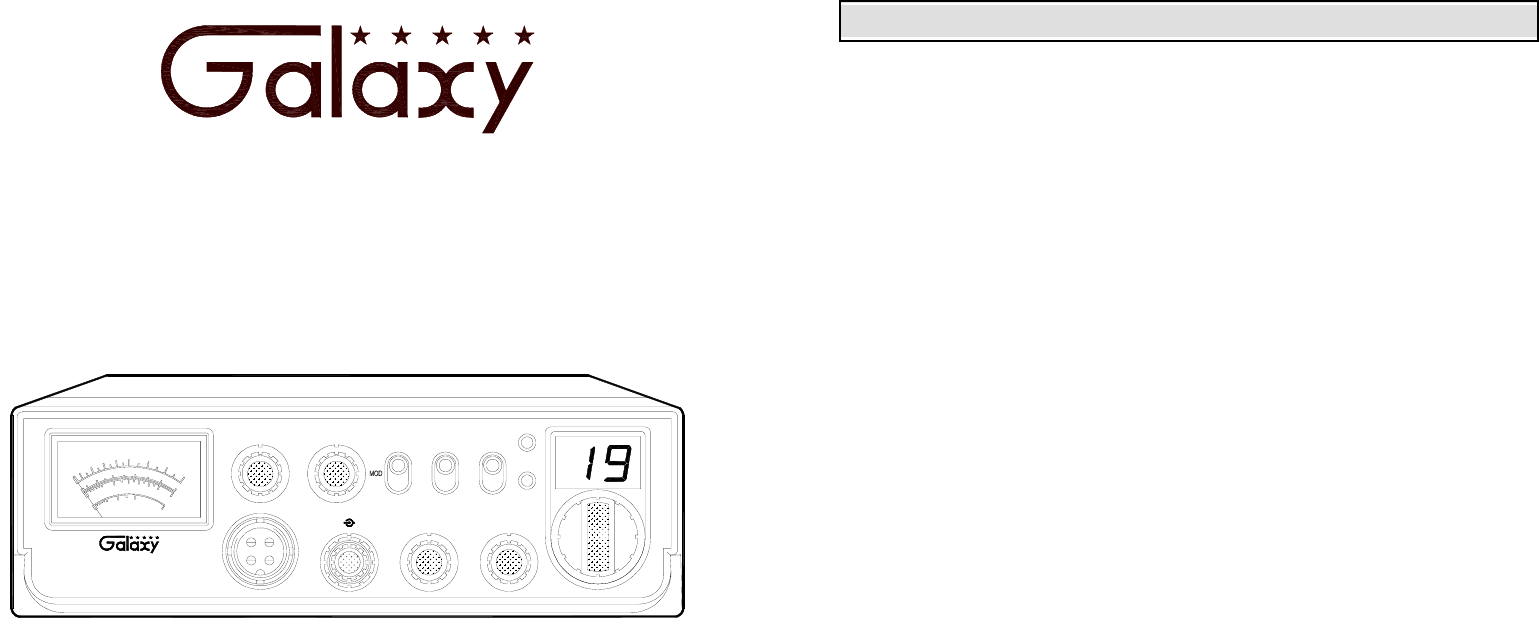
DX 929
Two Way
Citizen Band Mobile Transceiver
With StarLite Face Plate
OWNER’S MANUAL
POWER
DX 929
VOL SQ
OFF
MIC GAIN
RF GAIN DIMMER
PA
NB/ANL
CB
SWR
PWR
HI
OFF
TALKBACK
LO
RX/TX
SWR
3
0
SWR
1
20
PWR
MOD
S
+40
80
+60
50
3
30
40
60
40
2
1.5
1
5
10
20
100%
MAX
+20
7
5
9
dB
- 1 -
TABLE OF CONTENTS
PAGE
CHAPTER 1
Specifications . . . . . . . . . . . . . . . . . . . . . . . . . . . . . . . . . . . . . . . . . . . . . . . . 2
CHAPTER 2
Installation . . . . . . . . . . . . . . . . . . . . . . . . . . . . . . . . . . . . . . . . . . . . . . . . . . 3
Installing The Radio . . . . . . . . . . . . . . . . . . . . . . . . . . . . . . . . . . . . . . . . . . 3
Ignition Noise Interference . . . . . . . . . . . . . . . . . . . . . . . . . . . . . . . . . . . . . 4
Antenna . . . . . . . . . . . . . . . . . . . . . . . . . . . . . . . . . . . . . . . . . . . . . . . . . . . . 4
External Speaker . . . . . . . . . . . . . . . . . . . . . . . . . . . . . . . . . . . . . . . . . . . . . 4
Public Address . . . . . . . . . . . . . . . . . . . . . . . . . . . . . . . . . . . . . . . . . . . . . . 4
CHAPTER 3
Operation . . . . . . . . . . . . . . . . . . . . . . . . . . . . . . . . . . . . . . . . . . . . . . . . . . . 5
Front Panel . . . . . . . . . . . . . . . . . . . . . . . . . . . . . . . . . . . . . . . . . . . . . . . . . 5
Rear Panel . . . . . . . . . . . . . . . . . . . . . . . . . . . . . . . . . . . . . . . . . . . . . . . . . . 8
Frequency Chart . . . . . . . . . . . . . . . . . . . . . . . . . . . . . . . . . . . . . . . . . . . . . 9
Procedure to Receive and Transmit . . . . . . . . . . . . . . . . . . . . . . . . . . . . . . 10
Alternate Microphone and Installation . . . . . . . . . . . . . . . . . . . . . . . . . . . . 11
Maintenance And Adjustment . . . . . . . . . . . . . . . . . . . . . . . . . . . . . . . . . . 14
A Few Rules That Should Be Obeyed . . . . . . . . . . . . . . . . . . . . . . . . . . . . 15
How Your CB Can Serve You . . . . . . . . . . . . . . . . . . . . . . . . . . . . . . . . . . 15
Use Channel 9 For Emergency Message Only . . . . . . . . . . . . . . . . . . . . . . 16

- 2 -
CHAPTER 1 SPECIFICATIONS
GENERAL
Model DX 929
Channels 40
Frequency Range 26.965 ~ 27.405 MHz
Frequency Control Phase-Lock-Loop (PLL) Synthesizer
Frequency Stability 0.001%
Temperature Range -30°C to +50°C
Antenna Impedance 50 Ohms
Antenna Connectors Standard SO-239 type
Input Voltage 13.8V DC
Size 7 3/8” (W) x 8 3/4” (D) x 2 1/4” (H)
Weight 4.2 lbs.
TRANSMITTER
RF Power Output AM 3.8 watts
Spurious Emission > -60 dB
Unwanted Sideband -50 dB
Audio Distortion 10%
Frequency Response 300 to 2500 Hz
Microphone Dynamic
RECEIVER
Sensitivity for 10 dB (S+N)/N < 0.5 uV
Squelch Sensitivity < 0.5 uV
Selectivity > -50 dB
Image Rejection > 60 dB
Hum & Noise > -40 dB
AGC Figure of Merit 50 mV for 10 dB Change in Audio Output
Audio Power Output 2.5W @ 10% Distortion
Audio Response 300 to 2500 Hz
(SPECIFICATIONS SUBJECT TO CHANGE WITHOUT NOTICE)
- 3 -
CHAPTER 2 INSTALLATION
INSTALLING THE RADIO
Choose a convenient location for operation that does not interfere with driver or
passenger. This radio is supplied with a universal mounting bracket. When mounting
the bracket and radio to your car, make sure it is mechanically strong. Also, provide a
good electrical grounding connection to the chassis of vehicle. Proceed as follows to
install the radio.
1. Locate a convenient area in your vehicle for the installation of the radio. Hold the
mounting bracket with the radio in the location where the radio is to be installed.
Make sure nothing will interfere with either the radio or the mounting bolts. Mark
and then drill holes for the mounting bracket.
2. Most radio antennas come equipped with a PL-259 plug. Connect this plug to the
ANT. Jack in the rear of the radio.
3. Extending from the rear of the radio is a fused red and black wire for the DC
connections to the vehicle’s electrical system. For best performance, it is strongly
recommended that the red lead be taken directly to the positive terminal on the
vehicle’s battery and the black lead be connected to the nearest chassis ground.
(Note: This radio is designed for vehicles with negative ground systems.)
Connections should be made using appropriate “crimp on” lugs of a size large
enough to make good contact with the bolt used to fasten to the battery and the
chassis ground. It is a good safety idea to install a second fuse that would provide
protection in case the red wire was to “fray” or get pinched and short to the body
of the vehicle, somewhere between the battery and the radio.
High power radios such as this one require large DC current flow when in the TX
mode. Poor power connections cause supply voltage drops that can substantially
decrease the performance of your radio. A good DC connection is probably one of
the most important things for getting the best transmitter performance and in some
cases, least receiver noise.
4. Mount the microphone bracket near the radio in an easily accessible spot using the
two screws provided.
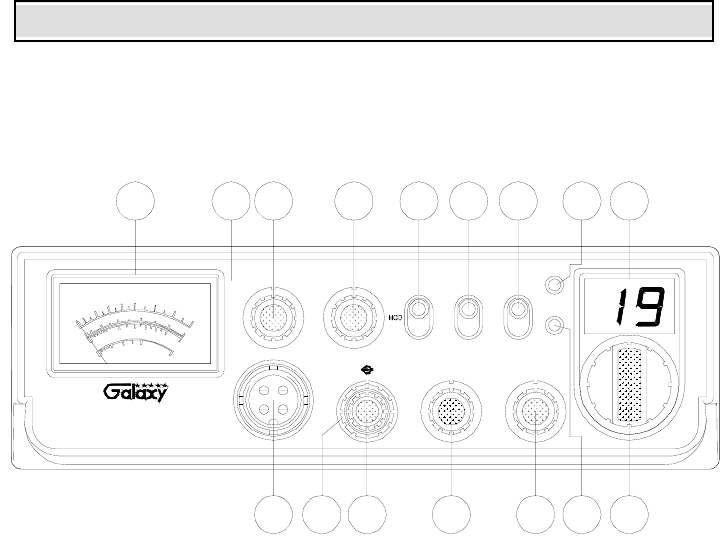
- 4 -
IGNITION NOISE INTERFERENCE
With weak signals, you may experience interference of the signal by background
noise. This radio has NB and ANL circuits which will help reduce background noise
from sources such as your ignition system. However, background electrical noise may
come from several sources and all noise may not be eliminated. With extremely weak
signals, you can operate this radio with the engine turned off, which should improve
reception. If the ignition noise level is too high to allow proper operation under most
conditions, you should have your installation of the radio checked by a qualified
technician.
ANTENNA
This radio has a jack in the rear for a standard PL-259 antenna plug. If you are
looking for the most range for your transmission, use a vertically polarized, quarter-
wave length antenna. If antenna height is a problem, you may use a shorter, loaded-
type whip antenna although you can expect some loss of transmission range.
To improve performance, your antenna should be matched to your radio. Your
antenna can be adjusted so that it matches your radio.
EXTERNAL SPEAKER
The external speaker jack (EXT SP.) on the rear panel is used for remote receiver
monitoring. The external speaker should have 8 ohms impedance and be able to
handle at least 3.8 watts. When the external speaker is plugged in, the internal speaker is
disconnected.
PUBLIC ADDRESS
To use the Public Address (PA) function, first connect an external speaker to the PA.
SP. Jack on the rear of the radio. See the above specifications for a proper external
speaker. Keep the speaker away from the microphone to avoid acoustic feedback.
- 5 -
CHAPTER 3 OPERATION
CONTROL FUNCTIONS
FRONT PANEL
1. MICROPHONE JACK: Used to connect microphone for voice source.
2. SQUELCH CONTROL: This knob is used to eliminate background noise being
heard through the receiver, which can be disturbing when no transmissions are
being heard through the receiver. To use this feature, turn the knob fully
counterclockwise and then turn clockwise slowly until the background noise is
just eliminated. Further clockwise rotation will increase the threshold level which
a signal must overcome in order to be heard. Only strong signals will be heard at a
maximum clockwise setting.
3. ON/OFF VOLUME CONTROL: This knob controls the volume and power to
the radio. To turn radio on, rotate the knob clockwise. Turning the knob further
will increase the volume of the receiver.
4. MIC GAIN CONTROL: Adjusts the microphone gain in the transmit and PA
modes. This controls the gain to the extent that full talk power is available several
929DX
PWR
SWR
OFF
RF GAIN
VOL SQ
DIMMER
HINB/ANL
OFFCB
PA
MIC GAIN
SWR
RX/TX
LO
POWER
TALKBACK
123 4 567
8 9 10 11 12 13 14 15 16
3
0
SWR
1
20
PWR
MOD
S
+40
80
+60
50
3
30
40
60
40
2
1.5
1
5
10
20
100%
MAX
+20
7
5
9
dB
- 6 -
inches away from the microphone. In the Public Address (PA) mode, the control
functions as the volume control.
5. POWER CONTROL: This control allows the user to adjust RF power output.
6. SWR LED: This LED lights red when your SWR is higher than about 3:1. This is
not an exact indicator of 3:1 SWR, but it is an indication that you should check
your SWR reading.
7. CHANNEL SELECTOR: This control is used to select the desired transmit and
receive channel.
8. FRONT PANEL METER: The front panel meter allows the user to monitor
signal strength, RF output power, SWR level and AM modulation level.
9. ILLUMINATED FACE PLATE: All faceplate lettering will fully illuminate to
allow the user easy viewing at night. This unique, solid state, backlight is
designed to maximize night vision while minimizing eye fatigue. Therefore, it is
ideal for switch and control recognition day or night.
10. RF GAIN CONTROL: This control is used to reduce the gain of the RF
amplifier under strong signal conditions.
11. DIMMER CONTROL: This knob controls the level of brightness for the meter
lamp and channel display.
12. SWR/MOD/PWR SWITCH: This switch controls the function of the meter
during the transmit mode. In the “SWR” position, the meter indicates the Standing
Wave Ratio (SWR) of your antenna. There are no adjustments because the SWR
circuit in this radio calibrates itself automatically. When the switch is in the
“MOD” position, the green scale on the meter indicates your percentage of
modulation in the AM mode only. It is most accurate when testing at maximum
power output. When this switch is in “PWR” position, the meter indicates your
power output.
13. NB-ANL/CB/PA SWITCH: When the switch is in the NB/ANL position, the
Noise Blanker (NB) and Automatic Noise Limiter (ANL) circuits are activated.
The Noise Blanker is very effective in eliminating repetitive impulse noise such
as ignition interference. In the CB position, the PA function is disabled and the
radio will transmit and receive on the speaker that is connected. In the PA position,
the radio acts as public address amplifier. Your voice will come out of the speaker
that is plugged into the PA. SP. jack on the rear panel. The radio does not operate
when you are in the PA mode.
- 7 -
14. TALKBACK (TB) SWITCH: This switch is used to monitor your own voice.
For example, you could use this feature to compare different microphones.
15. RX/TX LED: The red LED indicates the unit is in the transmit mode. The green
LED indicates the unit is in the receive mode.
16. CHANNEL DISPLAY: The channel display indicates the current selected
channel.
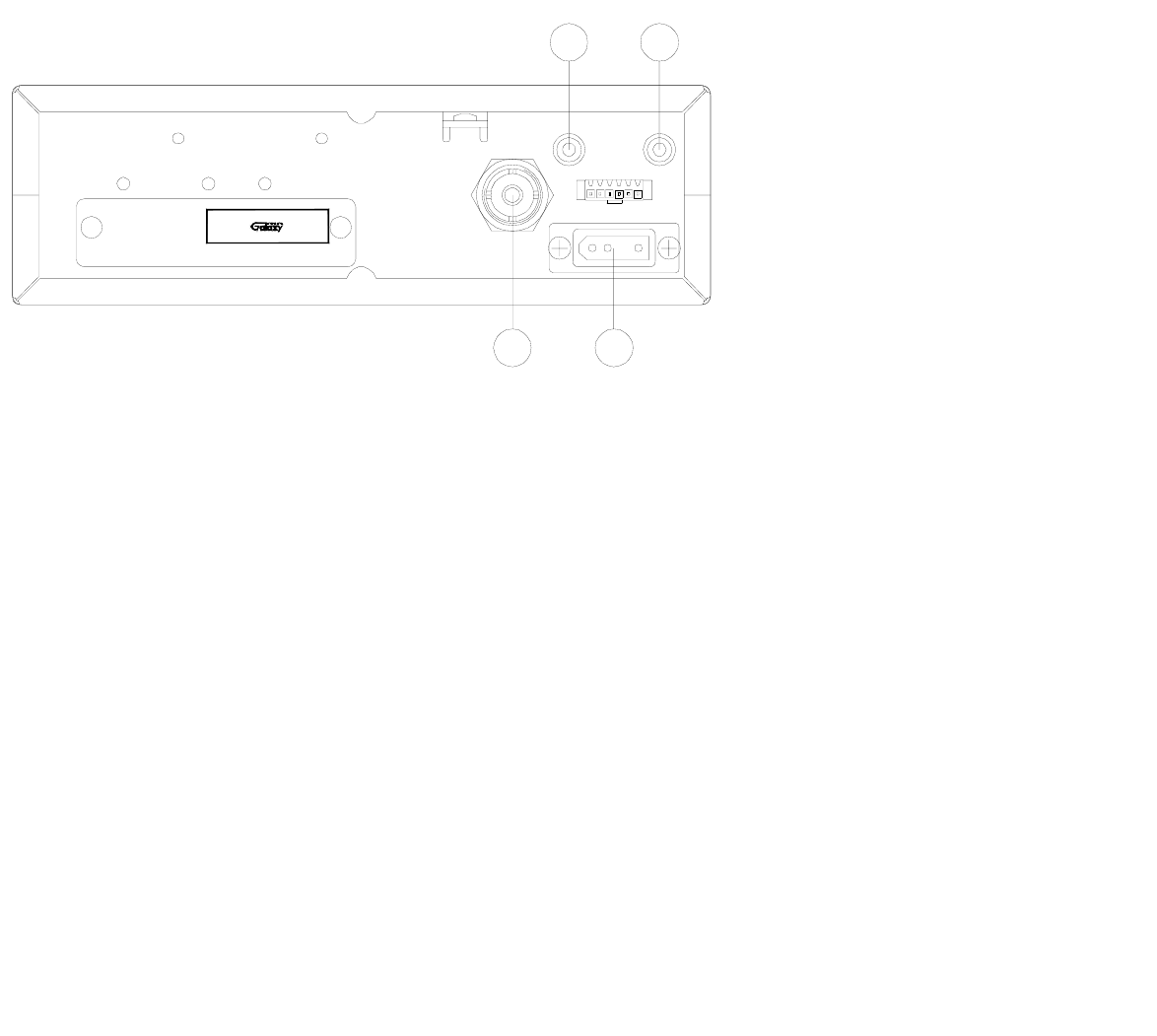
- 8 -
REAR PANEL
1. ANTENNA: This jack accepts a 50-ohm coaxial cable with a PL-259 type plug.
2. DC POWER: This jack accepts the 13.8V DC power cable with built-in fuse.
The power cord provided with the radio has a black and red wire. The black goes
to negative and red goes to positive.
3. PA SP: This jack is for PA operation. Before operating, you must first connect a
PA speaker (8 ohms, 4W) to this jack.
4. EXT. SP: This jack accepts a 4 to 8 ohm, 5-watt external speaker. When the
external speaker is connected to this jack, the built-in speaker will be disabled.
- 6 -
SERIAL NO. :
FCC ID : MEE − DX − 929
DATE OF MFG.:
AM 40 CH
CB TRANSCEIVER
MODEL NO. : DX 929
MADE IN CHINA
- DC 13.8V +
MADE IN CHINA
PA SP.
ANT
F.C.
EXT SP.
1 2
43
- 9 -
FREQUENCY CHART
Channel Channel Frequency Channel Channel Frequency
1 26.965 MHz 21 27.215 MHz
2 26.975 MHz 22 27.225 MHz
3 26.985 MHz 23 27.255 MHz
4 27.005 MHz 24 27.235 MHz
5 27.015 MHz 25 27.245 MHz
6 27.025 MHz 26 27.265 MHz
7 27.035 MHz 27 27.275 MHz
8 27.055 MHz 28 27.285 MHz
9 27.065 MHz 29 27.295 MHz
10 27.075 MHz 30 27.305 MHz
11 27.085 MHz 31 27.315 MHz
12 27.105 MHz 32 27.325 MHz
13 27.115 MHz 33 27.335 MHz
14 27.125 MHz 34 27.345 MHz
15 27.135 MHz 35 27.355 MHz
16 27.155 MHz 36 27.365 MHz
17 27.165 MHz 37 27.375 MHz
18 27.175 MHz 38 27.385 MHz
19 27.185 MHz 39 27.395 MHz
20 27.205 MHz 40 27.405 MHz
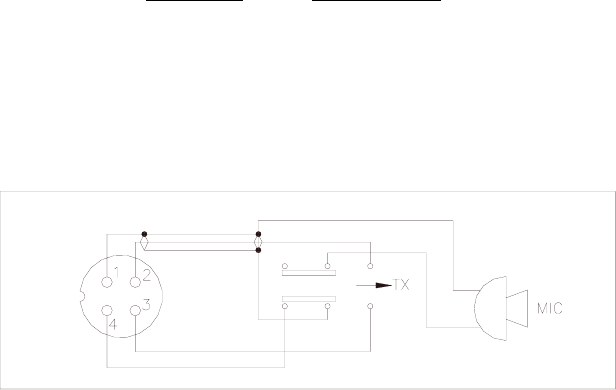
- 10 -
PROCEDURE TO RECEIVE AND TRANSMIT
A. MICROPHONE
The push-to-talk switch on the microphone controls the receiver and transmitter.
Press the switch and the transmitter is activated, release switch to receive. When
transmitting, hold the microphone two inches from your mouth and speak clearly in a
normal voice. This transceiver comes complete with a low impedance dynamic
microphone.
B. PROCEDURE TO RECEIVE
1. Be sure that power source, microphone and antenna are connected to the proper
connectors before going to the next step.
2. Turn VOL knob clockwise to apply power to the radio.
3. Set the VOL for a comfortable listening level.
4. Set the MODE switch to the desired mode.
5. Listen to the background noise from the speaker. Turn the SQ knob slowly
clockwise until the noise just disappears. The SQ is now properly adjusted. The
receiver will remain quiet until a signal is actually received. Do not advance the
control too far or some of the weaker signals will not be heard.
6. Set the CHANNEL selector switch to the desired channel.
C. PROCEDURE TO TRANSMIT
1. Select the desired channel of operation.
2. Set the MIC GAIN control fully clockwise.
3. If the channel is clear, depress the push-to-talk switch on the microphone and
speak in a normal voice.
- 11 -
ALTERNATE MICROPHONES AND INSTALLATION
For best results, the user should select a low-impedance dynamic type microphone
or a transistorized microphone. Transistorized type microphones have low output
impedance characteristics. The microphones must be provided with a four-lead cable.
The audio conductor and its shielded lead comprise two of the leads. The third lead is
for transmit control and fourth is for receiving control.
The microphone should provide the functions shown in the schematic below.
4 WIRE MIC CABLE
Pin Number Mic Cable Lead
1 Audio Shield
2 Audio Lead
3 Transmit Control
4 Receive Control
Fig. 1 Your transceiver microphone schematic.
If the microphone to be used is provided with pre-cut leads, they must be revised as
follows.
1. Cut leads so that they extend 7/16" beyond the plastic insulating jacket of the
microphone cable.
2. All leads should be cut to the same length. Strip the ends of each wire 1/8" and tin
the exposed wire.
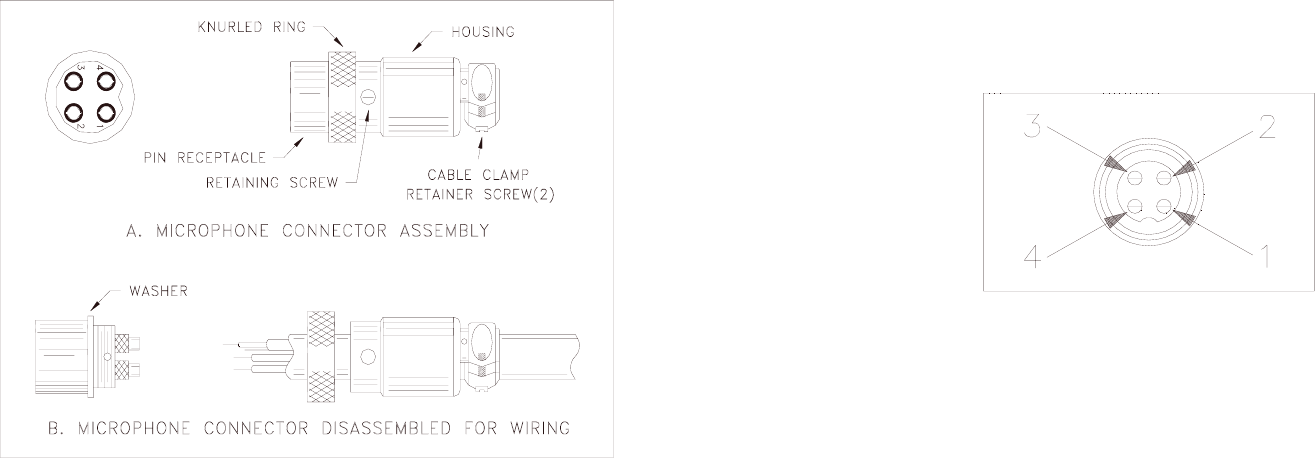
- 12 -
Before beginning the actual wiring, read carefully the circuit and wiring information
provided with the microphone you select. Use the minimum heat required in soldering
the connections. Keep the exposed wire lengths to a minimum to avoid shorting when
the microphone plug is reassembled.
Fig. 2 Microphone plug wiring
To wire the microphone cable to the plug provided, proceed as follows:
1. Remove the retaining screw.
2. Unscrew the housing from the pin receptacle body.
3. Loosen the two cable clamp retainer screws.
4. Feed the microphone cable through the housing, knurled ring and washer as
shown Figure 2.
- 13 -
5. The wires must now be soldered to the pins as indicated in the above wiring tables.
If a vise or clamping tool is available it should be used to hold the pin receptacle
body during the soldering operation, so that both hands are free to perform the
soldering. If a vise or clamping tool is not available, the pin receptacle body can
be held in a stationary position by inserting it into the microphone jack on the
front panel. The numbers of the microphone plug are shown in Fig. 3, as viewed
from the back of the plug. Before soldering the wire to the pins, pre-tin the wire
receptacle of each pin of the plug.
Fig. 3 Microphone plug pin numbers viewed from rear of pin receptacle.
6. Be sure that the housing and the knurled ring of Figure 2 are pushed back onto the
microphone cable before starting to solder. If the washer is not captive to the pin
receptacle body, make sure that it is placed on the threaded portion of the pin
receptacle body before soldering.
7. If the microphone jack is used to hold the pin receptacle during soldering
operation, best results are obtained when the connections to pin 1 and 3 are made
first and then the connections to pins 2 and 4. Use a minimum amount of
soldering and be careful to prevent excessive solder accumulation on pins, which
could cause a short between the pin and the microphone plug housing.
8. When all soldering connections to the pins of the microphone are completed, push
the knurled ring and the housing forward and screw the housing onto the threaded
portion of the pin receptacle body. Note the location of the screw clearance hole
in the plug housing with respect to the threaded hole in the pin receptacle body.
When the housing is completely threaded into the pin receptacle body, a final
fraction of a turn either clockwise or counterclockwise may be required to align
the screw hole with the threaded hole in the pin receptacle body. When these are
aligned, the retaining screw is then screwed into place to secure the housing to the
pin receptacle body.

- 14 -
9. The two cable clamp retainer screws should now be tightened to secure the
housing to the microphone cord. If the cutting directions have been carefully
followed, the cable clamp should secure to the insulation jacket of the microphone
cable.
10. Upon completion of the microphone plug wiring, connect and secure the
microphone plug in the transceiver.
MAINTENANCE AND ADJUSTMENT
This transceiver is specifically designed for the environment encountered in base
installations. The use of all solid state circuitry and its light weight result in high
reliability. Should a failure occur, however, replace parts only with identical parts. Do
not substitute.
NOTE
If the performance described in the OPERATION and
MAINTENANCE AND ADJUSTMENT sections is not
obtained, review the operating instructions to insure that proper
procedures were followed.
FCC WARNING
All transmitter adjustments other than those provided on front
panel by the manufacturer must be made by or under the
supervision of the holder of an FCC – issued general radio
telephone operator’s license.
- 14 -
- 15 -
A FEW RULES THAT SHOULD BE OBEYED
1. You are not allowed to carry on a conversation with another station for more than
five minutes at a time without taking a one-minute break, to give others a chance
to use the channel.
2. You are not allowed to blast others off the air by over-powering them with
illegally amplified transmitter power, or illegally high antennas.
3. You can’t use the transceiver to promote illegal activities.
4. You are not allowed to use profanity.
5. You may not play music in your transceiver.
6. You may not use your transceiver to sell merchandised or professional service.
HOW YOUR CB CAN SERVE YOU
1. Warn of traffic tie ups ahead.
2. Provide weather and road information.
3. Provide help fast in event of emergency or breakdown.
4. Suggest good spots to eat and sleep.
5. Make long trips more interesting, and help keep you awake.
6. Provide direct contact with your office or home.
7. Make friends for you as you travel.
8. Provide “local information” to find your destination.
9. Help law enforcement officers by reporting drunk and reckless drivers.

- 16 -
USE CHANNEL 9 FOR EMERGENCY MESSAGES ONLY
The FCC gives the following examples of permitted and prohibited types of
communications for use in an emergency. These are guidelines and are not intended to
be all inclusive.
Permitted Example Message
YES “A tornado sighted six miles north of town.
NO “This is observation post number 10. No tornado
sighted.
YES “I am out of gas on interstate 95”
NO “I am out of gas in my driveway”
YES “There is a four-car collusion at exit 10 on the
Beltway, send police and ambulance.”
NO “Traffic is moving smoothly on the Beltway”
YES “Base to Unit 1, the weather Bureau has just
issued a thunder storm warning. Bring the sailboat
into port.”
NO “Attention all motorists. The weather Bureau
advises that the snow tomorrow will accumulate 4
to 6 inches.
YES “There is a fire in the building on the corner of 6th
and Main Streets.”
NO “This is Halloween patrol unit number 3.
Everything is quiet here.”
MEMO

MEMO
MEMO

WARRANTY
This radio is covered by a two
year Limited parts and labor
warranty.
“Limited” means that we will repair problems caused by factory defects or normal
use at no charge.
Before returning a radio to us for warranty service, please call our Service
Department for a Repair Authorization Number (RAN). This RAN must be
written below your return address on the outside of the shipping box. Boxes,
which arrive without an RAN, will be refused, and the shipping company will
return the unopened box to you. Be sure to have a pen and paper ready along with
the serial number of your radio before calling. We will give you the RAN and our
shipping address over the phone. The telephone number of the Service
Department is (760) 480-8800, and we suggest calling between 10:00 AM and
4:00 PM Pacific Time.
Please include a note with a detailed description of the symptoms. This is
important because it will help the technician who works on your radio to locate
your problem. Intermittent problems are easily overlooked, so be sure to give as
much detail as possible in your note. Also, please include your daytime telephone
number in case our technicians have any additional questions.
Do not send your power cord or microphone unless we ask for these items during
our telephone conversation.
You are responsible for getting the radio safely to us. (We suggest using United
Parcel Service.) You must pay to ship the radio to us, and we will pay to ship the
radio back to you. Since we use UPS and they do not ship to Post Offices boxes,
please provide us with a street address for the return of your radio.
We will repair and return your radio as soon as we can. We appreciate your
choosing a Galaxy radio and we want you to be on the air as much as possible!
Be sure to visit our web site at
www.GalaxyRadios.com
Printed in China
AT240N010D